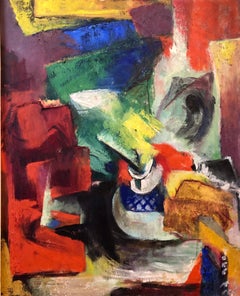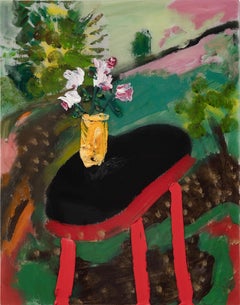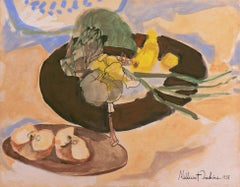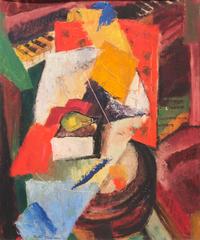Beulah Stevenson Art
to
2
2
1
1
Overall Height
to
Overall Width
to
1
1
1
2
3
6,847
3,161
2,517
1,217
2
1
1
1
1
Artist: Beulah Stevenson
Beulah Stevenson 1950s Abstract Expressionism American Woman Artist Oil Painting
By Beulah Stevenson
Located in Surfside, FL
Dimensions: 32"h, 25"w canvas; 38.5"h, 32"with frame
Work is titled "Two Lillies"
Elsie Stevenson (1890–1965) was an American painter and printmaker.
Beulah Stevenson, (1875-1965) American painter and printmaker. Born in Brooklyn Heights, Beulah (Elsie Sloan) Stevenson lived there her entire life. In New York she studied at the Pratt Institute and the Art Students League, where her instructors included Ashcan artist John Sloan; in Provincetown, she worked and studied with Abstract Expressionist artist Hans Hofmann (an influential teacher whose students included many notable artists including Lee Krasner, Helen Frankenthaler, Irene Rice Pereira, Gerome Kamrowski, Fritz Bultman, Wolf Kahn, Marisol Escobar and Beulah Stevenson), a long-time curator at the Brooklyn Museum, was also among his pupils. Her work appeared in many group shows, and she won a number of awards. She was a curator at the Brooklyn Museum for many years, and that museum owns a number of examples of her work, as do the Library of Congress and the New York Public Library. Stevenson maintained many professional associations during her career; she was president of the New York Society of Women Artists, a board member of the National Association of Women Artists, and a vice-president of the Brooklyn Society of Artists, Art Institute of Chicago, International Graphic Society Inc., Philadelphia Print Club, Provincetown Art Association and the Creative Artist's Association. She also belonged to the American Artists' Congress which promoted social-realist style of American scene painting, she left to join the Federation of Modern Painters and Sculptors established To Promote Avant-Garde Art. Stevenson was said by a friend to have destroyed many of her papers prior to her death, but a collection was donated to the Archives of American Art at the Smithsonian Institution.
Select Group Exhibitions
Art Institute of Chicago; , Library of Congress, Washington, D.C.; Print Club of Philadelphia; National Arts Club, New York; Metropolitan Museum; Whitney Museum; Brooklyn Museum; Chicago Art Institute; Pennsylvania Academy Of Fine Arts; Rochester Memorial Museum; St. Paul Museum; M. H. De Young Memorial Museum Of Art; Houston Museum Of Art; William R. Nelson Museum Of Art; Columbus Museum Of Art; American Institute Of Graphic Arts; Provincetown Art Association; Columbia Museum Of Art; Schenectady Museum Of Fine Art; Portland Museum, ME; Royal Society, London; Gallery O...
Category
Mid-20th Century Abstract Expressionist Beulah Stevenson Art
Materials
Canvas, Oil
Beulah Stevenson, Three Small Sunflowers and Two Roses by the Window
By Beulah Stevenson
Located in New York, NY
This Three Small Sunflowers still-life by Beulah Stevenson (1890-1965) is a joyful modernist composition. With just touches of color she indicates a window and colorful curtains blow...
Category
Mid-20th Century Modern Beulah Stevenson Art
Materials
Watercolor
Related Items
Black Table Red Legs
By Darius Yektai
Located in Sag Harbor, NY
A painting from the popular "black table" series by Darius Yektai.
Category
2010s Abstract Expressionist Beulah Stevenson Art
Materials
Epoxy Resin, Oil, Canvas
'Still Life, Jade and Gold', Woman Artist, Berkeley, San Francisco Museum of Art
Located in Santa Cruz, CA
Signed lower right, 'Millicent Tomkins' for Millicent Hanson Tomkins (American, 1930-2021) and dated 1957.
Millicent Tomkins began painting at a young age and, as a child, was award...
Category
1950s Modern Beulah Stevenson Art
Materials
Paper, Gouache
H 10.75 in W 13.25 in D 0.13 in
Abstract Expressionist Red Floral Still Life
By Allie William Skelton
Located in Soquel, CA
Bold floral abstract expressionist still life by Allie Bill Skelton (American, 1942-1986). Unsigned but was acquired with a collection of other Skelton pieces. Unframed. 30"H x 24"W.
Allie William “Bill” Skelton (American, 1942-1986) was a painter and sculptor active in San Francisco who was involved in the gay art scene of the 1960s and 1970s. "Transition" Bronze sculpture, 1984, on permanent display at Grower's Square, Downtown, Walnut Creek...
Category
Late 20th Century Abstract Expressionist Beulah Stevenson Art
Materials
Canvas, Oil
Watercolor Still life Painting Vegetables Claus Hoien Greengrocer Kitchen Series
Located in Surfside, FL
Delicate watercolor of vegetables. Japanese eggplant and radishes and a squash gourd.
Framed 18 X 20 image is 11 X 13.5
Claus Hoie was a Norwegian-American...
Category
20th Century American Modern Beulah Stevenson Art
Materials
Watercolor
Originals-Magic Bell Triptych-UK Awarded Artist-Botanical Abstract Expression
Located in London, GB
To Shizico, a triptych is a compilation of visual prayers; it embodies a meditative voyage akin to a form of meditation. For her, the repetition of motifs within the triptych serves ...
Category
2010s Abstract Expressionist Beulah Stevenson Art
Materials
Gesso, Canvas, Oil, Acrylic, Wood Panel
H 15.75 in W 35.44 in D 0.12 in
Original-CamelliasPink WillowTree-Abstract-Weaver-feat.Tartan-UK Awarded Artist
Located in London, GB
2024, Shizico Yi takes on an innovative project she named it "The Weaver," inspired by the heritage of family's Tartan, the rich lineage and history of the Clan. Within the patterns...
Category
2010s Abstract Expressionist Beulah Stevenson Art
Materials
Gesso, Oil, Acrylic, Canvas
H 19.53 in W 15.56 in D 0.6 in
Cecilia Arrospide - TRAVESIA, Painting 2022
By Cecilia Arrospide
Located in Greenwich, CT
Cecilia studied Social Studies and Literature at Universidad Catolica del Peru, Drawing with Cristina Galvez, and Watercolors with Juan Pastorelli. She...
Category
2010s Abstract Expressionist Beulah Stevenson Art
Materials
Canvas, Paint, Cotton Canvas, Oil
Untitled (Still Life)
Located in Chicago, IL
A colorful Modernist, still-life painting of fruit by New Jersey artist Israel Winarsky. This work comes from the estate of the2,500 artist. Image is double-sided. There is a wate...
Category
1950s American Modern Beulah Stevenson Art
Materials
Watercolor
Garden Flowers
By Charles Demuth
Located in New York, NY
Charles Demuth was one of the most complex, talented, and deeply sensitive artists of the American modern period. Whether he was painting floral still lifes, industrial landscapes, or Turkish bathhouses, art was, for Demuth, fraught with personal meaning. A fixture of the vanguard art scene in New York, Demuth navigated the currents of Modernism, producing some of the most exquisite watercolors and original oil paintings in twentieth-century American art.
Demuth was born in Lancaster, Pennsylvania, the only child of a well-to-do family. He had an awkward and introverted childhood shaped by a childhood illness, Perthes, a disease of the hip that not only left him permanently lame, but, as part of the “cure,” bedridden for two years in the care of his mother. This long period of incapacitation had a deep impact on Demuth, who came to see himself as an invalid, an outsider who was different from everyone else. It was perhaps during this period of indoor confinement that his keen interest in art developed. Several relatives on his father’s side had been amateur artists, and, following his convalescence, his mother encouraged his artistic pursuits by sending him to a local painter for instruction. The majority of his early pictures are of flowers, a subject for which Demuth maintained a lifelong passion.
Following high school, Demuth enrolled at the Drexel Institute of Art in Philadelphia, a school renowned for its commercial arts program. He advanced through the program rapidly, and, in 1905, at the encouragement of his instructors, he began taking courses at the Pennsylvania Academy of the Fine Arts. The two leading teachers then at the Academy were William Merritt Chase and Thomas Anshutz. Anshutz, himself a former student of Thomas Eakins, was well liked by his students, and is best known as the teacher of Robert Henri, John Sloan, and several of the other artists of the Ashcan School. Demuth, too, adopted a similar idiom, working in a controlled, realistic manner while at the Academy, where he remained until 1910.
In 1907, Demuth made his first trip to Europe, staying in Paris. He spent time on the periphery of the art scene composed of the numerous American artists there, including John Marin and Edward Steichen. He returned to Philadelphia five months later, and immediately resumed courses at the Academy. Despite his introduction to advanced modern styles in Europe, Demuth’s work of this period retains the academic style he practiced before the trip. It wasn’t until he had summered at New Hope, Pennsylvania, in 1908 and 1911, that his style began to evolve. New Hope was a prominent American Impressionist art colony whose members were largely affiliated with the Pennsylvania Academy. Demuth dropped the conservative tone of his style and adopted a freer and more colorful palette.
Although he remained based in Philadelphia, Demuth frequently went to New York during this period. Many of the same American artists of the Parisian art scene Demuth had encountered on his earlier European trip now formed the nucleus of New York’s avant-garde, which centered around Alfred Stieglitz’s 291 gallery. It wasn’t long before Demuth began to apply modernist-inspired strategies to his work. He was particularly influenced by the watercolor work of John Marin, also a former student of Anshutz, whose bold use of color in the medium Demuth freely adapted into looser washes of color.
In 1912, Demuth again left for Paris, this time studying in the Académie Moderne, Académie Colorossi, and Académie Julian. In Paris Demuth met the American modernist Marsden Hartley. Hartley, a principal figure in the expatriate art circle, acted as a mentor to Demuth, and introduced him to the wide array of modern styles currently practiced in Europe. Hartley also introduced Demuth to many of the members of the Parisian avant-garde, including Gertrude Stein. Demuth was an aspiring writer, and he spent many hours in conversation with Stein. He wrote extensively during this period, and published two works shortly after his return to America. He also developed an interest in illustrating scenes from literary texts. From 1914 to 1919, Demuth produced a series of watercolors of scenes from books such as Emile Zola’s Nana and Henry James’s The Turn of the Screw.
Upon his return to America, Demuth settled in New York. In 1914, Demuth had his first one-man show at Charles Daniel’s gallery, which promoted emerging modern American artists, including Man Ray, Rockwell Kent, Yasuo Kuniyoshi, Stuart Davis, and Max Weber. Demuth drew closer to the artistic vanguard in New York, becoming friends with many in the Stieglitz and Daniel circles, including Georgia O’Keeffe, Marcel Duchamp, Carl Van Vechten, and Edward Fiske.
New York’s cosmopolitan atmosphere and active nightlife appealed greatly to Demuth. In a sketchy style well suited to watercolor, he painted many vaudeville and circus themes, as well as nightclub, café, and bathhouse scenes. Often with Duchamp, Demuth took part in an urban subculture replete with nightclubs, bars, drugs, and sexual permissiveness, which, for a homosexual artist like himself, allowed room for previously unattainable personal expression. Demuth’s pictures of sailors, bathhouses, and circus performers embody a sensual and sexual undercurrent, expressing the artist’s sense of comfort and belonging in the bohemian subculture of New York.
Simultaneously, Demuth deepened his interest in floral pictures, painting these almost exclusively in watercolor. His style evolved from the broad color washes of his earlier pictures to more spare, flattened, and sinuous compositions, inspired by the drawings of Aubrey Beardsley and other artists of the Aesthetic Movement. Demuth’s flower watercolors are moody and atmospheric, sensuous and elegant, introspective and yet full of expressive power. Moreover they are beautiful, and are unequivocally among the finest still lifes in American art. Despite numerous subsequent artistic undertakings that led him in a variety of directions, Demuth never stopped painting flower pictures, ultimately adding fruits and other still-life objects to his repertoire.
In 1916, Demuth began to develop a style later known as Precisionism, a form of landscape painting infused with Cubism, in which space is divided into precisely drawn geometric regions of color. Demuth first began to paint the landscape in an appropriated Cubist mode while on a trip with Hartley to Bermuda. In these early landscapes, in which the curvilinear forms of trees intersect the geometrically articulated architectural forms, Demuth explored ideas that shaped the future development of modernism in America.
The full realization of Demuth’s explorations came after his return to America in 1917, when he turned his attention to industrial subjects. These works derive from a “machine aesthetic,” espoused by New York artists such as Francis Picabia, Joseph Stella, Albert Gleizes, and Duchamp, by which artists viewed machines as embodying mystical, almost religious significance as symbols of the modern world. Rather than painting the skyscrapers and bridges of New York as did most of his like-minded contemporaries, Demuth returned to his home town of Lancaster, where he painted factories and warehouses in a Precisionist idiom. The titles for these pictures are often contain literary references, which serve as clues for the viewer to aid in the decoding of the artist’s meaning.
In 1923, Demuth planned a series of abstract “poster portraits” of his friends and contemporaries in the New York art and literary scene. In these “portraits,” Demuth combined text and symbolic elements to evoke the essential nature of his sitters’ distinguishing characteristics. In this fashion, he painted portraits of such artists as Georgia O’Keeffe, John Marin, and Arthur Dove. His most famous poster portrait, I Saw the Figure 5 in Gold...
Category
20th Century American Modern Beulah Stevenson Art
Materials
Paper, Watercolor
"Pink Flowers" Abstract Expressionist oil and resin painting of flora polka dots
By Darius Yektai
Located in Sag Harbor, NY
A rare small painting from contemporary Abstract Expressionist, Darius Yektai. Although titled "pink flowers" the hue of the painting is really more peach, or a light orange. A patte...
Category
2010s Abstract Expressionist Beulah Stevenson Art
Materials
Canvas, Linen, Resin, Epoxy Resin, Raw Linen, Oil
Deep Night
By Robert Petrick
Located in Los Angeles, CA
Deep Night
1988/89
24 inches x 30 inches
oil on canvas
Artist Statement: This is an early work I produced in my studio at 11th street and Ave 'B" NYC...
Category
1980s Abstract Expressionist Beulah Stevenson Art
Materials
Canvas, Oil
Still Life at a Table, Study in Yellow by Artist Harold Haydon
By Harold Haydon
Located in Chicago, IL
A ca. 1931 delightful watercolor still life at a table; a study in yellow by artist Harold Haydon.
Harold Emerson Haydon was born in Fort William, Ont...
Category
1930s American Modern Beulah Stevenson Art
Materials
Paper, Ink, Watercolor, Pen
Previously Available Items
Rhythm From Things on a Piano Stool
By Beulah Stevenson
Located in Santa Fe, NM
Provenance: Private Collection, Long Island, New York
Signed lower left, titled verso
Category
1940s Modern Beulah Stevenson Art
Materials
Canvas, Oil
Beulah Stevenson art for sale on 1stDibs.
Find a wide variety of authentic Beulah Stevenson art available for sale on 1stDibs. You can also browse by medium to find art by Beulah Stevenson in paint, canvas, fabric and more. Much of the original work by this artist or collective was created during the 20th century and is mostly associated with the modern style. Not every interior allows for large Beulah Stevenson art, so small editions measuring 15 inches across are available. Customers who are interested in this artist might also find the work of John von Wicht, Sylvia Rutkoff, and Anya Spielman. Beulah Stevenson art prices can differ depending upon medium, time period and other attributes. On 1stDibs, the price for these items starts at $1,500 and tops out at $12,000, while the average work can sell for $6,750.




